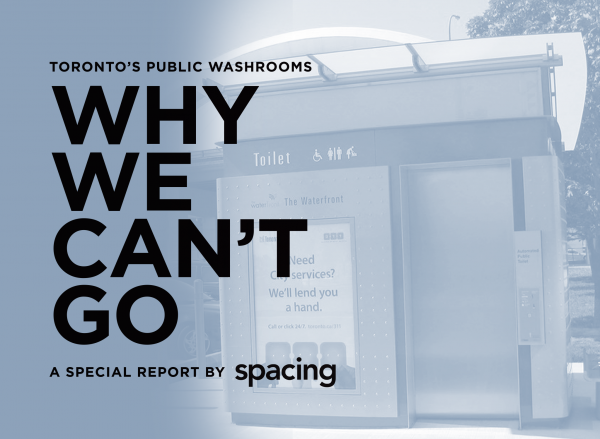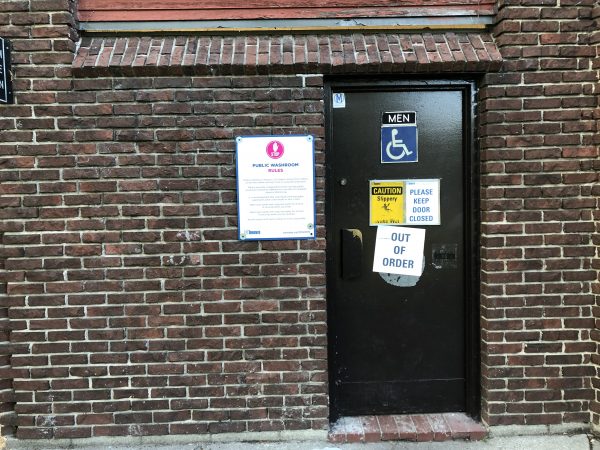Parks Forestry and Recreation (PFR), according to City of Toronto data, operates over 1,500 parks, nearly 700 sports fields, 123 community recreation centres, 59 indoor and 59 outdoor swimming pools, 52 outdoor ice rinks, 41 arenas and hundreds of sport courts and other smaller facilities.
Within this far flung empire of activity, there are washrooms at 155 community recreation facilities (e.g., arenas, indoor pools, recreation centres, field/clubhouses), 57 outdoor pools, and 51 outdoor rinks, as well as 187 park washroom buildings, approx. 140 of which open are only between May and October (that’s about one per 21,000 people, or one for every ten parks). Since 2017, the City has opened seven new washrooms, mostly in areas with lots of development, but also in popular parks, such as Tommy Thompson. (The figures don’t include civic buildings like Metro Hall or police stations.)
An embarrassment of riches, or merely an embarrassment?
Consider Tommy Thompson. For years, the spit was served by portable toilets at three locations, despite tens of thousands of visitors at all times of the year. They date back to a master plan drawn up for the park in 1987 and revised in 1992. It took 30 years for the city to provide permanent facilities. The spit itself, now 250 ha, has grown at a faster pace.
While the moral (and aesthetic) stigma that clings to public washrooms has long been a limiting factor in their upkeep, money is the other crucial blockage, although on this file, the money story — tight budgets — is far more complicated than many would assume, or indeed as the City characterizes its fiscal pressures.
PFR doesn’t exactly know how much it costs to operate the City bathrooms, as the supplies and maintenance are folded into larger budgets. But even these aren’t very big: janitorial and cleaning supplies run to about $870,000 per year, only a portion of which is spent on bathrooms. The City can’t isolate the cost of the staff time allocated to bathroom upkeep because the PFR employees perform other tasks on their shifts.
It’s also not entirely clear why PFR closes public washrooms at dusk. The explanation could have to do with shift times — plausible — but it could also reveal traces of the moralism that is handed down from another era, when night time use of public space was frowned on.
PFR also says that maintenance on bathrooms is funded either from the City’s operating budget or, with larger fixes, from the debt-financed capital budget. The frequent refrain, which we can all sing by heart, is that budgets have been tight, or inadequate, for years.
Yet there’s a Dr. Jekell/Mr. Hyde quality to the discussion of the money earmarked for parks. Thanks to Section 42 of the Planning Act, developers have to provide either land or cash, calculated by a complicated formula, for parkland acquisition or “other parkland recreational purposes.” The money, plus whatever interest it accrues, is held in reserve funds.
Which are huge, and growing rapidly — faster, in fact, than PFR can spend it all. Between 2016 and 2019 alone, according to City documents, some $440 million from about 1,500 development projects flowed into these reserves, with PFR investing about $173 million on various park acquisition and development projects. As of the end of 2019, those reserves held a total of $645 million, and the city had earmarked about two-thirds of that sum for projects planned for this decade.
Nor is that flow of funding going to slow anytime soon. The Ford government, in its sweeping overhaul of planning laws, threatened to repeal Section 42, as it did with the Section 37 grants for community benefits, but then changed its mind.
I have no problem with the City holding money in a rainy day fund; it’s prudent budgeting and expensive problems do arise, such as the massive flooding that destroyed a lot of ravine infrastructure in 2008. That said, refurbishing park washrooms so they can be used in the winter and are in compliance with the Accessibility for Ontarians with Disabilities Act (AODA) has always been an investment option available to PFR planners, but one they’ve mostly avoided.
As an aside, according to a spokesperson, PFR isn’t aware of any city-wide audit of the accessibility of public washrooms. Any new structures, including washrooms, need to be accessible and satisfy the Toronto Accessibility Design Guidelines, adopted in 2018. But those bathrooms built prior to 2005, which is to say most of them, only need to be brought into compliance during a major renovation. In other words, if the city chooses not to refurbish a public washroom, it is under no legal obligation to make that facility accessible.
The City has a lengthy list of investments planned for its parks for 2021-2030, including almost $300 million for new, enhanced or refurbished amenities, from playgrounds to cricket pitches, ice rinks and skating trails. Click on this report, issued in January, 2021, and you’ll note that the word `washroom’ doesn’t warrant a single mention.
In response to public outcry, however, the City in October, 2021, released a subsequent report laying out the parameters of its so-called washroom enhancement program, “with,” as the document said, “the aim of identifying opportunities and advancing additional retrofits and new builds for 2022/2023 and future years.” As of this writing, there are no further details.
It’s easy to get lost in the bureaucratic jargon of capital plans and bureaucratic priorities, so I’d argue that the most important way to think through this ridiculous problem is to begin with first principles:
Toronto is growing. More people are living in apartments and thus relying on parks. The City is plowing hundreds of millions of dollars into said parks to make them more interesting, engaging and active. And all those new users will need a place to go.
A few more:
- Every public bathroom should be OADA compliant; that’s table stakes.
- Parks that are designed to attract parents with young children, athletes consuming liquids to remain hydrated, or older people who may be out for a stroll but are also contending with continence issues, should always be equipped with permanent washroom amenities.
- City-managed public spaces should have signs that direct people to said washrooms.
- And the washrooms should be open when people are using the park, not when it’s convenient for the scheduling of PFR maintenance crews.
None of this is rocket science, to use the old cliche. And yet…
Just the other night, I was with my dog at the local park, a place I’ve been visiting since I moved in to this neighbourhood in 1995. It was a pleasant evening. The tennis courts were full. There were two games of pick-up going on at either end of the basketball court. The remnants of an end-of-school picnic was wrapping up. Lots of people, enjoying public space.
But the bathroom — tucked away at the back of the tennis club building, and located up a pair of stairs, unchanged from the day I first visited this place — was closed, the bolts secured in place by a pair of padlocks. After all, dusk had settled over this patch of green in our (almost) post-COVID city, so if you had to go, you were, ahem, shit out of luck.
photo by Shawn Micallef





